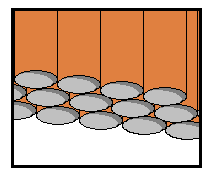Two Groups - classifying fungi into ascomycetes and basidiomycetes:
Boletes & Polypores
Boletes
In some ways the boletes are very mushroom-like. A bolete is a fleshy fruiting
body consisting of a cap on a stem - but with a spongy pore layer (rather than
gills) on the underside of the cap. In this photo of an undescribed species
of Austroboletus, you can see some of that spongy, pored layer.
You can imagine each pore to be the mouth of a short, vertical tube. Thus, the area beneath the cap superficially resembles a mass of closely-packed tubes, and an enlarged view of a small section of the underside of the cap is shown schematically in this diagram.

The inner walls of those tubes are lined with basidia. The walls themselves are composed of hyphae, in the same way as the body of a mushroom gill. The photo (above right) shows a bolete that has been cut in half vertically. The half on the left shows a view of the underside with its tiny, red pores. The half on the right shows that the white flesh of the cap and stem has blued on exposure to the air. You can also see a side-on view of the vertically sliced tubes that constitute the spore-producing area below the flesh of the cap.
Polypores
The polypores are a little like boletes, in that they also have pores that
are mouths of short, vertical tubes. Once again the inner walls of the tubes
are lined with basidia. The fruiting bodies have varied shapes. Some, like Polyporus
arcularius, consist of a cap on a stem but most polypores are either bracket-like
in form (such as Ganoderma australe ![]() and Phaeotrametes decipiens or, like Macrohyporia dictyopora
and Phaeotrametes decipiens or, like Macrohyporia dictyopora ![]() ,
more-or-less sheet-like and pressed closely to the underlying wood.
,
more-or-less sheet-like and pressed closely to the underlying wood.
![An Australian Government Initiative [logo]](/images/austgovt_brown_90px.gif)






